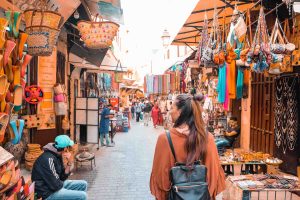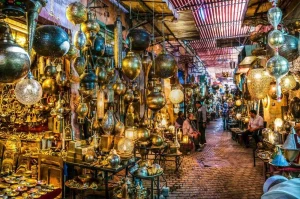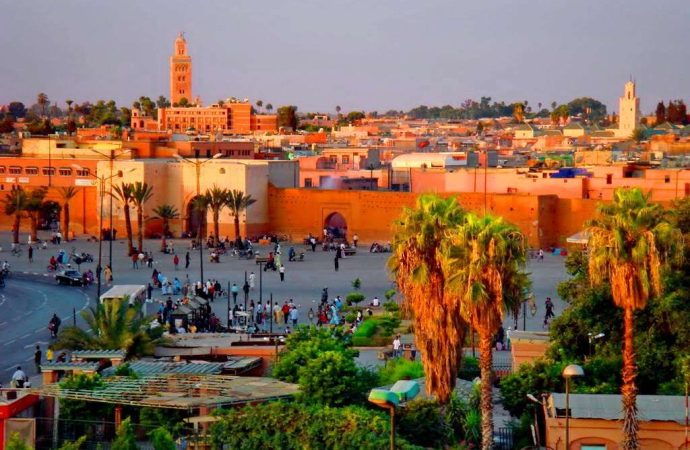Marrakech, often referred to as the “Red City” due to its distinctive red sandstone buildings, is a vibrant and historically rich destination in Morocco. This city, nestled at the foothills of the Atlas Mountains, offers an enchanting blend of ancient tradition and modern allure. Visitors are drawn to its labyrinthine streets, bustling souks, and awe-inspiring
Marrakech, often referred to as the “Red City” due to its distinctive red sandstone buildings, is a vibrant and historically rich destination in Morocco. This city, nestled at the foothills of the Atlas Mountains, offers an enchanting blend of ancient tradition and modern allure. Visitors are drawn to its labyrinthine streets, bustling souks, and awe-inspiring historical landmarks. This article delves into the exotic markets and historic sites of Marrakech, providing a comprehensive guide for those seeking to explore the cultural and architectural marvels of this mesmerizing city.
Exotic Markets in Marrakech
Marrakech is renowned for its bustling markets, known as souks, which are a sensory overload of sights, sounds, and smells. These markets are not just places of commerce but are also integral to the cultural fabric of the city.

Image by yandex.com
Souk Semmarine
Souk Semmarine is one of the largest and most famous markets in Marrakech. It is a maze of narrow alleys lined with shops selling a diverse array of goods, from traditional Moroccan lamps and carpets to spices and jewelry. The vibrant atmosphere is accentuated by the calls of vendors and the colorful displays of merchandise. Bargaining is a common practice here, and visitors are encouraged to haggle for the best prices.
Souk el Attarine
Specializing in spices and perfumes, Souk el Attarine is a fragrant journey through the scents of Morocco. Here, visitors can find an array of spices such as cumin, cinnamon, and saffron, as well as traditional Moroccan perfumes and essential oils. The souk is also known for its beautiful metalwork, including brass lamps and intricately designed teapots.
Souk des Teinturiers
This market is famous for its vibrant displays of dyed fabrics and yarns. Visitors can witness the traditional dyeing process, where artisans use natural dyes to color wool and silk. The sight of brightly colored fabrics hanging to dry in the sun is a visual treat. Souk des Teinturiers is also a great place to purchase unique textiles and handmade garments.
Rahba Kedima
Rahba Kedima, also known as the Spice Square, is a small but bustling market specializing in spices, dried herbs, and traditional remedies. The square is lined with stalls selling everything from medicinal plants to colorful powders used in Moroccan cuisine. It is an excellent place to learn about the traditional uses of various herbs and spices in Moroccan culture.
Historic Sites in Marrakech
Marrakech is steeped in history, with numerous historic sites that offer a glimpse into its rich past. These landmarks reflect the city’s architectural splendor and cultural heritage.
Koutoubia Mosque
The Koutoubia Mosque is one of Marrakech’s most iconic landmarks. Built in the 12th century, it is the largest mosque in the city and a prime example of Almohad architecture. The mosque’s minaret, standing at 77 meters, is a prominent feature of the Marrakech skyline. While non-Muslims are not permitted to enter the mosque, the exterior and the surrounding gardens are worth exploring.
Bahia Palace
Constructed in the late 19th century, Bahia Palace is a stunning example of Moroccan architecture. The palace was intended to be the grandest of its time, with intricately designed courtyards, lush gardens, and ornate rooms. Visitors can wander through the palace’s many chambers, each adorned with intricate stucco work, zellij tiles, and painted wooden ceilings.
Saadian Tombs
The Saadian Tombs date back to the reign of Sultan Ahmad al-Mansur in the late 16th century. These tombs were rediscovered in 1917 and have since become a popular tourist attraction. The site includes the mausoleum of the sultan and his family, with beautifully decorated chambers and gardens. The intricate tile work and stucco decoration are a testament to the craftsmanship of the Saadian era.
El Badi Palace
El Badi Palace, meaning “The Incomparable Palace,” was commissioned by Sultan Ahmad al-Mansur in the late 16th century. Although now in ruins, the palace was once a symbol of the sultan’s wealth and power. Visitors can explore the vast courtyards, sunken gardens, and remnants of grand halls. The palace also offers panoramic views of the city from its walls.

Image by yandex.com
Conclusion
Marrakech is a city where the past and present coexist harmoniously. Its exotic markets and historic sites provide a rich tapestry of experiences for visitors. Whether haggling for spices in the bustling souks or marveling at the architectural splendor of ancient palaces and mosques, Marrakech offers a journey through time and culture. This article has highlighted some of the key markets and historic landmarks, but the city has much more to offer for those willing to explore its hidden corners.
















